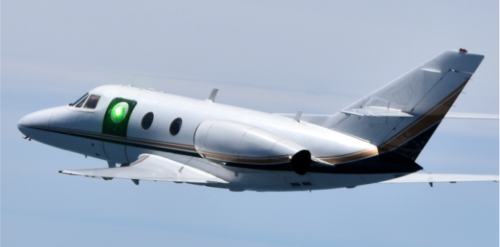The Air Force Research Laboratory (AFRL) has achieved a major breakthrough in laser technology for aircraft with its recent successful flight-test campaign. The project, known as HARDROC (Hybrid Aero-Effect Reducing Design with Realistic Optical Components), brings us closer to the future of directed energy laser systems integrated onto aircraft.

Photo from AFRL
The HARDROC program, a joint effort between AFRL’s Aerospace Systems Directorate and the Directed Energy Directorate at Kirtland Air Force Base, New Mexico, along with MZA Associates, a leading contractor, focused on testing a new beam director concept. Their goal was to assess the effectiveness of different aerodynamic flow control techniques in reducing distortions that occur when a laser beam is emitted from a fast-moving aircraft.
Rudy Johnson, the HARDROC program manager, expressed his excitement, stating, “The HARDROC beam director is a game-changer in minimizing aerodynamic issues. Through a series of flight tests, we successfully demonstrated how flow control techniques can significantly reduce the impact of aerodynamics on the beam director.”
The HARDROC program builds upon years of research by AFRL scientists in flow control. Using advanced computational fluid dynamic simulations, they were able to achieve remarkable reductions in aerodynamic effects across a wide range of speeds and angles. Dr. Scott Sherer, the CFD lead for the HARDROC program, highlighted the importance of these simulations, saying, “We used powerful computers provided by the Department of Defense to determine which flow control techniques would work best and deserve further exploration.”
The success of the HARDROC program is the result of close collaboration between the Aerospace Systems Directorate and the Directed Energy Directorate. Dr. Matthew Kemnetz, co-principal investigator for Aero-Effects and Beam Control in AFRL’s Directed Energy Directorate, praised the HARDROC team, stressing the importance of the flight test data in advancing airborne beam director technology.
While advanced flow control techniques are at the core of the HARDROC program, integrating them with realistic optical components was crucial for proving the system’s effectiveness. MZA Associates, a renowned company specializing in high-energy lasers and advanced optical systems, partnered with AFRL to design a smaller-scale system for testing in wind tunnels and on an aircraft. In 2022, the HARDROC beam director successfully underwent flight tests on a business jet. The collected data confirmed that the HARDROC technology enables directed energy systems to operate with fewer aerodynamic disturbances, providing a 360-degree field of view across different speeds. Moreover, the HARDROC beam director is smaller, lighter, and requires less power compared to other similar systems.
Dr. Mike Stanek, Technical Advisor for the Aerospace Systems Directorate’s Integrated Systems Branch, highlighted the significance of this breakthrough, saying, “The successful flight demonstration of the HARDROC turret overcomes a crucial technological hurdle for using high-power lasers on fast aircraft for various Air Force missions.” Integrating the compact and efficient HARDROC turret will enhance mission performance compared to other integration strategies.
For more information, hit the Source below